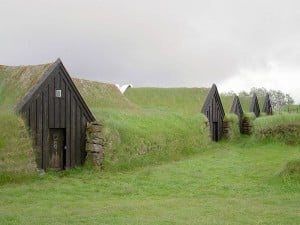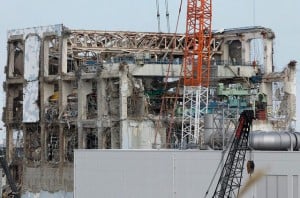Graphic: Torus Design naturally-built house – powered by LENR.
“The effects precede the causes” —Marshall McLuhan
To appropriate the language of art and psychology, a figure is recognized in relation to a ground. A figure is not seen by the eye without a ground.
Our total environment is a constantly morphing ground from which technological figures appear and disappear.
Though there is some ratio of feed-back and feed-forward, the ground precedes the technology. Technological figures form from this ambient environment. Materials are manufactured, networks are created, and people are educated. A set of services and disservices structure the environment, foreshadowing the imminent recognition of the fresh figure.
A new energy technology is now being developed to provide an unprecedented level of power, cleanly, cheaply, and with the smallest footprint of any other form of energy ever exploited by humans. This emerging figure is intimated by the increase in activity forming the environment that services the new fire.
Scientists are making exponential advances in experimental research and theory, inventors have moved to engineering over proto-typing, distribution networks about entrepreneurial ventures are contouring a new physical geography of Earth, and designers are beginning to incorporate cold fusion technology into their architectures.
As revolutionary as this energy up-grade is, the first commercial product utilizing this technology will be a very familiar steam generator to provide hot, clean water, and heating. Andrea A. Rossi‘s E-cat is available on the market right now, though you might not know it. The currently hand-crafted units only come in the 1MW-thermal size, and are solely for industry and agency use. The current status of the domestic line of E-cats is being closely guarded while Underwriters Laboratory works through their certification process.
But Owen Geiger isn’t waiting around. He’s begun to incorporate LENR technology into designs for sustainably-built and -operated homes supplied with green, energy-dense power, completely off-grid.
Founder and Director of the Geiger Research Institute of Sustainable Building in Crestone, Colorado, U.S., Dr. Owen Geiger, has two engineering degrees and a doctorate in Social and Economic Development. Dr. Geiger was a former director of Builders Without Borders and his designs have been implemented in crisis situations around the world. He worked closely with Habitat for Humanity for 7 years and mentored housing officials with the United Nations Institute for Training and Research.
Devoted to finding solutions to the world’s housing problems, Dr. Geiger believes the answer lies in education-helping people help themselves. He calls for a global housing initiative to address the unprecedented level of homelessness in substandard housing around the world. He has developed an expertise in natural building and Earthbag buildings and is the author of Earthbag Building Guide, a complete how-to on building Earthbag homes. [visit]
And, he has been researching LENR with the goal of fully-implementing this new ultra-clean energy technology into natural building. Cold fusion energy generators will initially provide hot water, clean water, home-, barn-, and garage-heating. The first small, portable units will be perfect for keeping a greenhouse warm for those in higher latitudes.
The Torus is “the first home specifically designed for the E-Cat/LENR fusion energy system”, according to Geiger. “E-Cats or Low Energy Nuclear Reaction (LENR) technology, promises clean, nearly free energy that will likely rank as one of the most important discoveries in history.”
“LENR technology can provide extremely low cost energy that doesn’t pollute or create nuclear wastes”, writes Geiger. “LENR creates distributed/decentralized energy where it’s needed – right in your home, for instance. This eliminates transmission losses and frees us from dependence on big businesses that are prone to manipulating prices. Distributed energy means you’re not reliant on the grid or vulnerable to grid disruptions. A blizzard, for instance, can’t knock out your power.”
Geiger says the Torus is based on the shape of an electromagnetic field. Looking at the plans, the Torus has all the elements of a modern home heated by a LENR energy generator, yet it retrieves the roundness of ancient design.

We asked Owen Geiger how it was that he came to see the advantages of LENR energy technology for natural building.
Q&A with Natural Builder Owen Geiger
CFN When did you first hear about the new cold fusion technology that is just now emerging? What were your first thoughts?
OG I’ve read about alternative energy developments for quite a few years. Rossi’s public demonstrations starting in January, 2011 caught my eye and I’ve followed cold fusion research much more closely since then.
CFN What prompted you to begin incorporating an E-cat/LENR generator into your home designs?
OG I guess I was looking for a way to spread the word and help this technology take hold. How could I bridge the disconnect between proposed energy devices and actual applications?
CFN Can you describe some of the features that make this home specifically suited to cold fusion heating, hot water, as well as power?
OG Envisioning a more sustainable cold fusion future encompasses home designs that harmonize with LENR principles. Roundhouses in general are very strong, energy efficient, and provide maximum space using a given amount of materials. That’s probably why they’ve been so popular down through the ages in many cultures. The wind, for instance, will blow around the structure versus building up pressure against flat surfaces. Round shapes work with nature rather than against it. Same is true with cold fusion. Possible features include radiant floor heating, water heating and power generation.
CFN What is a general figure for the cost to build one of these homes? How long would you estimate it would take to build the Torus – assuming you had a LENR generator all ready to go?!
OG The Torus design can be built with earthbags (tamped earth in sand bags), straw bales, adobe, stone and other materials to create low cost, energy efficient 18” thick walls. The choice of materials depends on factors such as climate, what materials are locally available, skill sets, building codes and so on. Construction costs vary considerably from region to region. The only way to accurately determine the cost is by making a cost estimate based on local costs.
CFN As a sustainability expert in natural home-building, what do you see in the future for green home power? Do you see solar and wind providing the kind of power we want for a technological future, or do you see cold fusion energy usurping the conventional alternatives?
OG In the near term, we can choose from a variety of renewables. Use what makes most sense in your situation. Micro-hydro is very efficient. Wind and solar is practical in some areas. Having more than one system is often a good idea. Long term, I see LENR as the leading contender for renewable power. Nothing else that I’m aware of will be able to match the cost, efficiency and practicality of cold fusion.
CFN Are there any techniques to build a house to keep you safe from radioactivity?

Here’s a another example: http://earthbagplans.wordpress.com/2010/09/20/earthbag-survival-shelter/

Secondly, you could have a fully underground structure, but for severe emergencies only. Now that I think of it, you could build a small underground earthbag dome for sleeping in your backyard, possibly add a tunnel between your house and the dome. This would protect you from radiation for 1/3 of the day.

CFN Has anybody bought the Torus Design plans yet?
OG Yes, it’s proven quite popular. Everyone has different needs and so most clients opt for a custom plan. Options include using part of the home as a granny suite or rental, adding extra bedrooms or even a 2nd story.
CFN Thanks Dr. Geiger. Any final thoughts?
OG I encourage people to do their own research about LENR. For instance, look at what’s happening with nanotechnology and other developments that will enable LENR to flourish. Doing an image search on Google turns up cutting edge materials such as nickle-embedded nanotubes, metal-doped SWNTs, and more. Vary the search words a little and you can find almost anything imaginable either already in the marketplace or in the research pipeline.
CFN Good advice, and thanks again. How can people contact you for more info on sustainable building and natural homes?
OG You’re welcome, Ruby. Anyone interested in a fixed quote on custom plans can email me at: strawhouses [at] yahoo.com or visit my Natural Building Blog http://naturalbuildingblog.com/.
…Related Links…
LENR confirmed by mainstream scientists by Owen Geiger on Natural Building Blog
Torus Design by Owen Geiger on Natural Building Blog
Natural building plans can be ordered from Dream Green Homes.com
McLuhan the Younger: Two New Books by Roy Christopher











